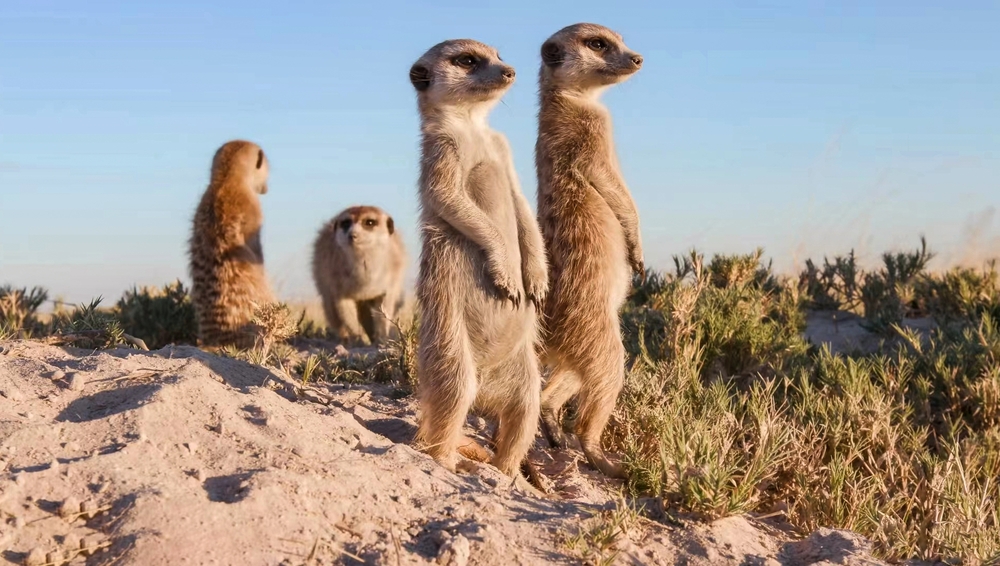Meerkat Mobsters: The Surprising Social Structure of Desert Dwellers
Amidst the sun-scorched plains of southern Africa, a peculiar society thrives. Meerkats, those charismatic desert sentinels, have captured the hearts of animal lovers worldwide. But behind their adorable facade lies a complex social structure that rivals the most intricate human organizations. This article delves into the fascinating world of meerkat society, exploring their hierarchical dynamics, cooperative behaviors, and the unexpected parallels to human criminal syndicates.

The Alpha Pair: Leaders of the Pack
At the helm of every meerkat mob sits the alpha pair, a dominant male and female who hold the reins of power. These individuals assert their authority through various means, including scent marking, aggressive displays, and even physical confrontations. The alpha pair enjoys numerous privileges, such as priority access to food and the exclusive right to reproduce within the group. This monopoly on breeding ensures that their genes are passed on to future generations, perpetuating their leadership lineage.
Sentinels: The Watchful Eyes of the Mob
One of the most crucial roles within a meerkat mob is that of the sentinel. These vigilant individuals take turns standing guard, perched atop termite mounds or other elevated positions, scanning the horizon for potential threats. Sentinels emit a series of calls to alert the group of approaching predators, allowing others to focus on foraging or other activities. This cooperative behavior significantly enhances the mob’s chances of survival in their predator-rich environment.
The Babysitting Brigade: Cooperative Child-Rearing
Meerkat pups require constant care and protection, a task that falls to the entire mob. While the alpha female is responsible for birthing the pups, other group members take on the role of babysitters. These individuals, often subordinate females or young males, stay behind at the burrow to guard and care for the pups while the rest of the mob forages. This cooperative child-rearing system ensures the survival of the next generation and strengthens social bonds within the group.
Mob Mentality: Collective Decision-Making and Defense
When faced with threats or important decisions, meerkats exhibit a remarkable level of coordination and collective action. For instance, when confronted by a predator, the mob will often band together, creating a unified front to intimidate the threat. This mob mentality extends to other aspects of their lives, such as deciding when to move to a new foraging area or selecting a new burrow site. The group’s cohesion and ability to act as a single unit contribute significantly to their survival in the wild.
The Dark Side of Meerkat Society: Infanticide and Exile
Despite their seemingly idyllic cooperative nature, meerkat society has a darker underbelly. Infanticide, the killing of young pups, is not uncommon, particularly when subordinate females attempt to breed. The alpha pair may eliminate these unauthorized offspring to maintain their breeding monopoly. Additionally, individuals who challenge the established hierarchy or repeatedly break social norms may face exile from the group, a potentially fatal punishment in the unforgiving desert environment.
Parallels to Human Criminal Organizations
The hierarchical structure and behavioral patterns observed in meerkat mobs bear striking resemblances to human criminal syndicates. The alpha pair’s dominance and control over resources mirror the leadership of crime bosses. The mob’s collective defense strategies and coordinated actions reflect the loyalty and unity often seen in criminal organizations. Even the practice of exiling or eliminating threats to the established order draws parallels to the brutal practices of human criminal groups.
Conservation Challenges: Protecting Meerkat Habitats
As fascinating as meerkat societies are, these creatures face numerous threats in the wild. Habitat loss due to human encroachment and climate change poses significant challenges to meerkat populations. Conservation efforts focus on preserving their natural habitats and educating local communities about the importance of these unique animals. The estimated cost of meerkat conservation projects can range from $50,000 to $500,000 annually, depending on the scale and scope of the initiatives.
In conclusion, the intricate social structure of meerkat mobs offers a captivating glimpse into the complexity of animal societies. From their hierarchical leadership to their cooperative behaviors, meerkats demonstrate that sophisticated social organizations are not unique to humans. As we continue to study and understand these remarkable creatures, we gain valuable insights into the diverse ways in which social animals adapt and thrive in challenging environments. The preservation of meerkat habitats and continued research into their behavior will undoubtedly yield further fascinating discoveries about these desert mobsters and their intricate social world.





